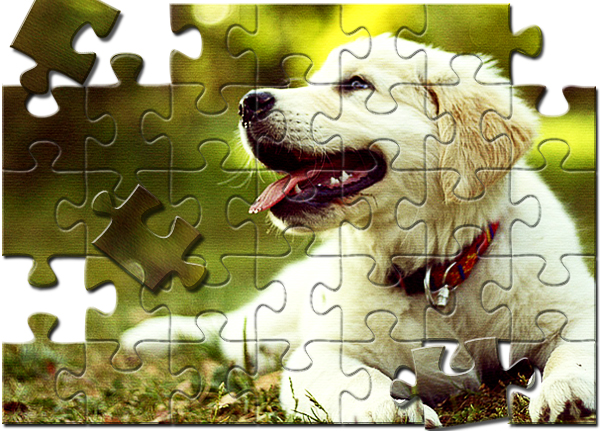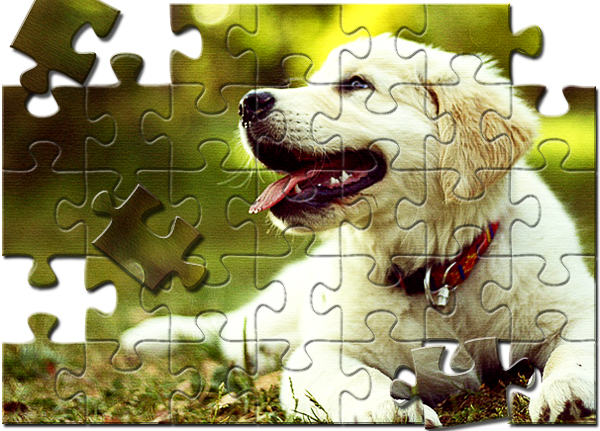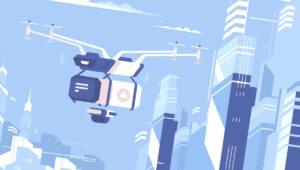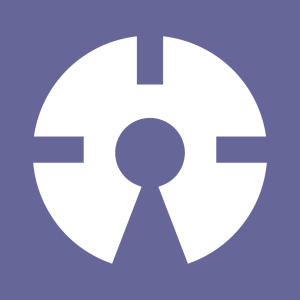Puzzles are symbolic for many things: an assembly of abstract parts into a cohesive whole, the solving of complex problems, and the combination of perfectly-fitting components. These contexts and connotations can be in high demand for designers, so having puzzles as a visual technique can be invaluable. In this tutorial, we’ll turn a photograph into a fun jigsaw puzzle. We’ll make everything from scratch, which will allow a greater control on your final outcome.
Along the way, you will learn the use of pen tool, few layer styling techniques and use of filter. I’ll also demonstrate how you can create your very own jigsaw puzzle pattern by following few easy steps. So, let’s get started!
Resources:
Dog by jeni cek
Jigsaw Puzzle Blank Template
Final result:

Step 1
Open the photograph in Photoshop.
Step 2
Duplicate the image layer by going to “Layer” > “Duplicate Layer.” We’ll apply the jigsaw puzzle effect on this duplicated image and keep the original image below it as a backup.
Step 3
We’ll do some color adjustments on the image before proceeding any further. Click on the icon to “Create new fill or adjustment layer” at the bottom of the layers panel and select the “Color balance” option. Apply the following settings for midtones, shadows, and highlights. Once you are done, merge the duplicated image and color balance layers. To do so, select both layers and press Ctrl + “E”.

Step 4
Next, we’ll give the image some texture. Click on the image layer to select it, go to “Filter” > “Filter Gallery” > “Texture” > “Texturizer”, and apply the following settings. Label this layer as “Textured”.

Step 5
Now I’ll show you how to make the jigsaw puzzle template. Create a new layer by going to “Layer” > “New Layer.” Select the pen tool (Tool mode: Shape), set fill to “none” and the stroke to 0.5pt in pure black color in the top properties bar. Draw the stroke shown below.
Step 6
Rasterize the stroke layer by going to “Layer”> “Rasterize”> “Shape”. Duplicate the stroke layer and flip it horizontally by going to “Edit” > “Transform Path” > “Flip horizontal”. Join both the stroke layers over each other with the help of Move tool (“V”). Now, select both the stroke layers and merge them by pressing Ctrl+ “E”.
Step 7
Duplicate the merged layer twice and position these copies below the original layer to make a continuous stroke like the one shown below. Merge these three layers into a continuous stroke.
Step 8
Duplicate the stroke layer, flip it horizontally and position it as shown below. Merge these two stroke layers, duplicate, and drag it towards the right side. Repeat the same technique until you cover the entire canvas. Once you are done, merge all the stroke layers and label the merged layer as “Vertical strokes”.
Merge these two stroke layers, duplicate, and drag it towards the right side. Repeat the same technique until you cover the entire canvas. Once you are done, merge all the stroke layers and label the merged layer as “Vertical strokes”.
Step 9
Duplicate the “Vertical strokes” layer and flip it 90⁰ by going to “Edit” > “Transform” > “Rotate 90⁰”. Position it as shown below to complete the puzzle template. In this way, by making a simple segment, you can make a complete puzzle.Step 10
I’ve made a jigsaw puzzle blank template using the same technique shown above. You can skip steps 5-9 if you want to use the template instead. Download the PNG file from the tutorial resources, go to “File” > “Place”, and choose the jigsaw puzzle blank template PNG file. This will place the puzzle inside the document you are working on. You can adjust the size of puzzle according to your image using the free transform tool (Ctrl+ “T”).
Step 11
Next, press Ctrl + <click on the puzzle template layer> to select it. After that, go to “Select” >“Inverse”. Now, click on the textured layer while the selection is still active and press Ctrl + “C” to copy it. Press Ctrl + “V” to paste the selection onto a new layer. Label this layer as “Photo Puzzle”. Hide rest of the layers except this one.
Step 12
Double-click on the “Photo Puzzle” layer and apply the following settings for “Bevel and Emboss” and “Drop shadow”.


Step 13
Our puzzle is looking fairly authentic so far. However, we can enhance it further. Select the pen tool (Tool mode: Shape), set the fill to any color you want, and stroke to “none”. Draw the shape of the puzzle piece that you want to move.
Step 14
Press Ctrl + <click on the puzzle piece layer> to select it. Now click on the “Photo Puzzle” layer and go to “Edit” > “Clear”. Create a new layer below the “Photo Puzzle” layer and fill it with pure white color using the paint bucket tool.
Step 15
Once again, make a selection around the puzzle piece layer. Now make the textured layer visible, press Ctrl + “C” to copy the selection on it and press Ctrl + “V” to paste it onto a new layer. Place this cut puzzle piece above the “Photo Puzzle” layer.
Step 16
Right-click on the “Photo Puzzle” layer, select the option of “copy layer style” and then right-click on the puzzle piece layer and choose “paste layer style” to apply the same effects on it. Double-click and modify the drop shadow settings on the puzzle piece. Rotate this piece a bit using the free transform tool (Ctrl + “T”) and arrange it as you like.
Rotate this piece a bit using the free transform tool (Ctrl + “T”) and arrange it as you like.

Step 17
Play along with the puzzle using the same techniques and create your own outcome. Here is my final result. That’s it guys. I hope you learned something interesting. Do share your thoughts!
That’s it guys. I hope you learned something interesting. Do share your thoughts!
Frequently Asked Questions (FAQs) about Breaking an Image into Puzzle Pieces in Photoshop
How Can I Create Different Shapes of Puzzle Pieces in Photoshop?
Photoshop allows you to create puzzle pieces in different shapes using the Custom Shape Tool. You can find this tool in the toolbar or by pressing U. Once you’ve selected the tool, go to the options bar and click on the shape dropdown menu. Here, you can select different shapes for your puzzle pieces. Remember to create a new layer for each shape to maintain flexibility in editing.
Can I Use This Technique to Create a Puzzle Animation?
Yes, you can use this technique to create a puzzle animation. After creating the puzzle pieces, you can animate them using the Timeline panel. You can move, rotate, and resize the pieces over time to create an animation. Remember to convert each piece into a smart object before animating to maintain the quality of the image.
How Can I Add a 3D Effect to My Puzzle Pieces?
You can add a 3D effect to your puzzle pieces using the Bevel & Emboss layer style. This style allows you to add depth and dimension to your pieces, making them look more realistic. You can adjust the depth, size, and direction of the bevel to achieve the desired effect.
Can I Save My Puzzle Pieces as Separate Images?
Yes, you can save your puzzle pieces as separate images. To do this, select each piece individually using the Marquee Tool, then go to File > Save As to save the piece as a separate image. Remember to save the images in a format that preserves the transparency, such as PNG.
How Can I Make My Puzzle Pieces Look More Realistic?
You can make your puzzle pieces look more realistic by adding textures and shadows. You can add textures using the Texturizer filter, which allows you to choose from different types of textures. You can add shadows using the Drop Shadow layer style, which allows you to adjust the distance, spread, and size of the shadow.
Can I Use This Technique with Other Adobe Software?
Yes, you can use this technique with other Adobe software. For example, you can create puzzle pieces in Illustrator using the Pen Tool, then import them into Photoshop for further editing. You can also animate the pieces in After Effects for more advanced animations.
How Can I Create a Puzzle Effect with More Pieces?
You can create a puzzle effect with more pieces by dividing your image into more sections. You can do this by increasing the number of rows and columns in the Divide Scanned Photos dialog box. Remember to create a new layer for each piece to maintain flexibility in editing.
Can I Use This Technique to Create a Collage?
Yes, you can use this technique to create a collage. After creating the puzzle pieces, you can replace each piece with a different image to create a collage. You can do this by placing the images on separate layers and using the Clipping Mask feature to clip the images to the pieces.
How Can I Share My Puzzle Image Online?
You can share your puzzle image online by saving it as a JPEG or PNG file, then uploading it to your preferred social media platform. Remember to save the image in a high-quality format to preserve the details of the puzzle pieces.
Can I Print My Puzzle Image?
Yes, you can print your puzzle image. To do this, go to File > Print to open the Print dialog box. Here, you can adjust the print settings to fit your needs. Remember to save your work before printing to prevent any loss of data.
Anum is Web and Graphic designer. Addicted to Photoshop and crazy for pixel perfection. She is also an active blogger, sharing her passions, skills and creative details on her blog Websoulz. She loves to connect with the community, sharing the latest design gossips and rolling her eyes on boring trends.




